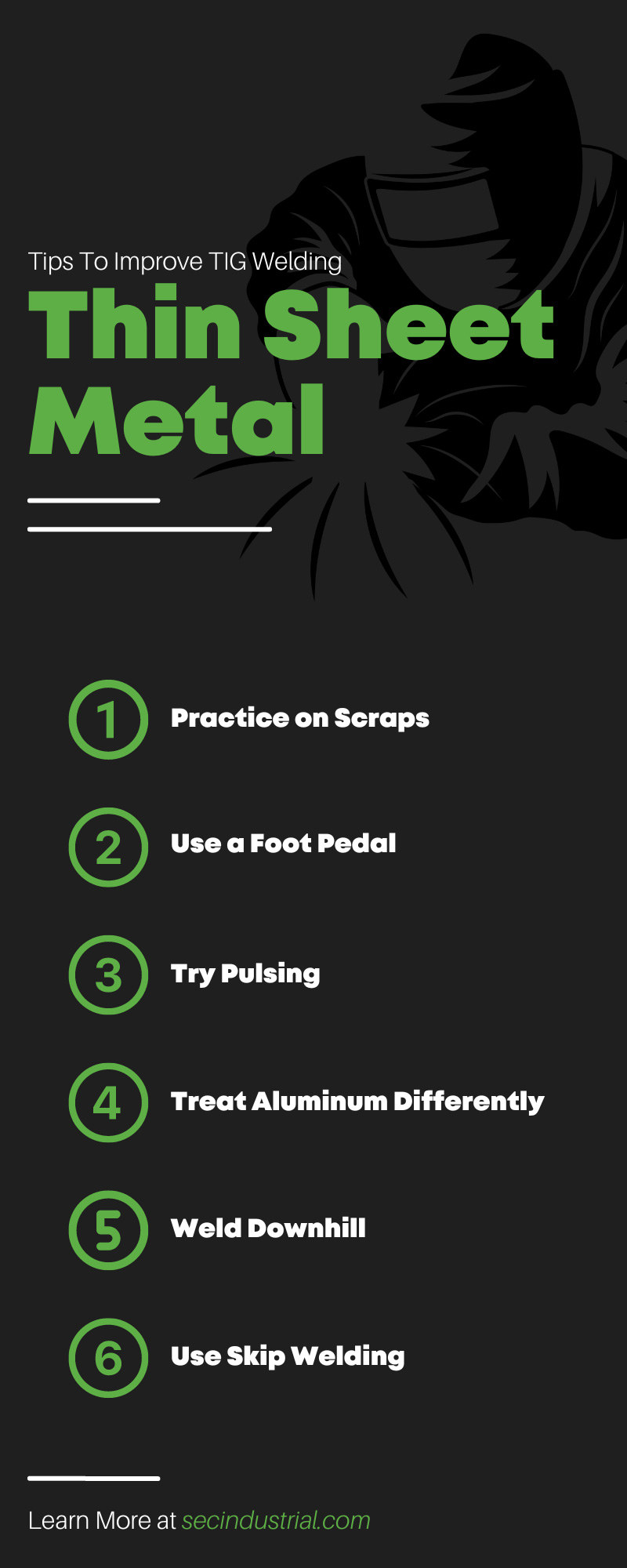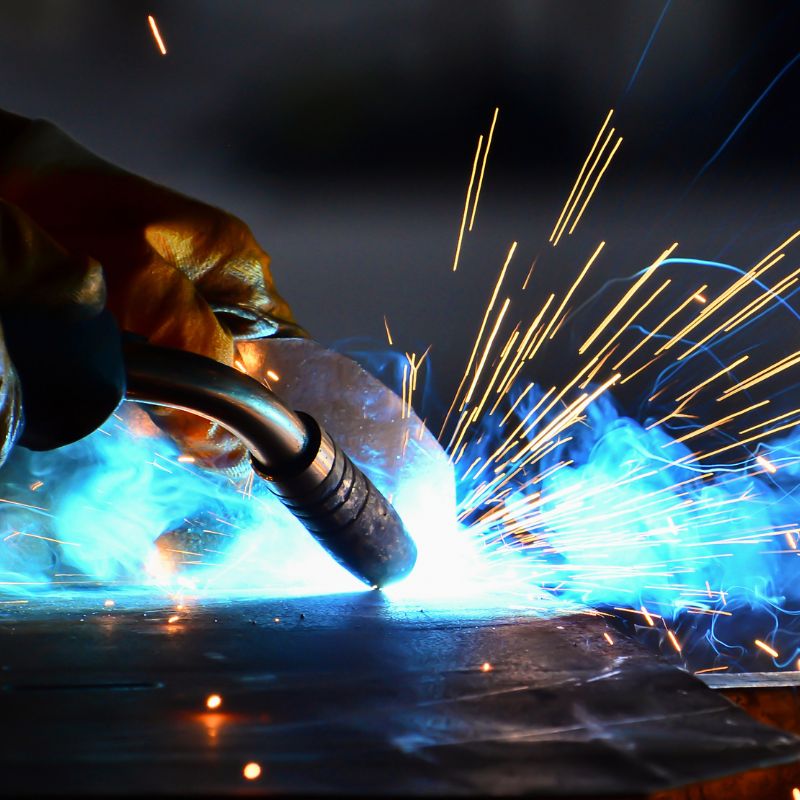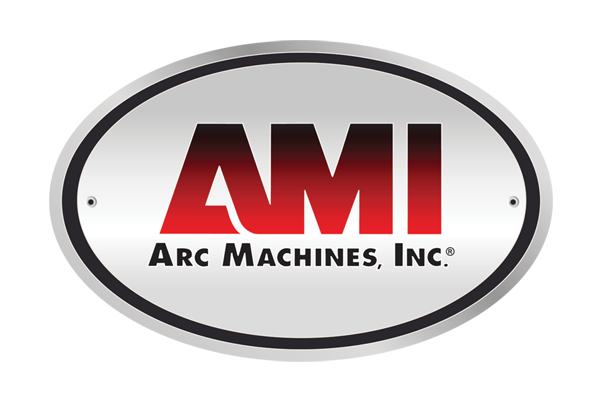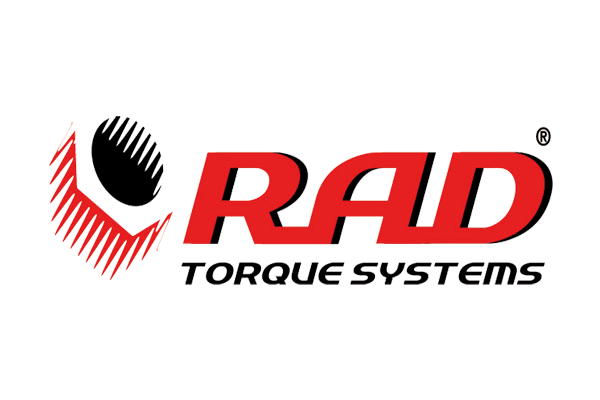10 Tips To Improve TIG Welding Thin Sheet Metal
The process of welding may not be very complicated, but that doesn’t mean welding is easy. Mastering welding techniques, like welding different thicknesses and types of metals, can take decades. Whether you’re a veteran welder or new to the field, take a look at these ten tips to improve TIG welding thin sheet metal.
What Makes Welding Thin Metal Difficult?
There are a lot of things that can go wrong when you’re welding. If your tool isn’t at the correct temperature, you can end up with splatters or uneven welds. With thin metal, the biggest concern is burning through since there’s very little metal to absorb all the heat. Most of the techniques on this list are designed to help reduce the chance of burn throughs.
1. Practice on Scraps
Before you start welding, test out your skills on some scrap metal of the same approximate thickness. This will allow you to get a feel for how much heat the metal can handle. It will also give you the chance to fine-tune your welding tool’s settings.
2. Use a Foot Pedal
While it isn’t necessary for every welding job, a foot pedal can make a huge difference when you’re working with thin materials. With thin metal, it’s very important that you hold your welding tool steady and pointed at exactly the right place. You don’t want to be fiddling with amperage settings when you’re trying to focus—that’s where the pedal comes in. The pedal lets you change settings with your foot so your hands can hold the welding tool still.
3. Try Pulsing
If your machine has the capability, you might try using pulsed TIG welding on thin metals. Pulsing changes the current from consistent to fluctuating, which reduces heat buildup. It also produces smoother welds and allows for a faster travel speed.
4. Treat Aluminum Differently
The advice on this list primarily pertains to TIG welding steel and stainless steel. If you have a project welding aluminum, know that you’re dealing with a completely different set of parameters. Aluminum is very soft and has an oxidized surface that makes welding more difficult. You’ll need to use a pure tungsten rod and argon shielding gas to get a good aluminum weld.
5. Weld Downhill
Another tip to improve TIG welding thin sheet metal is to weld downhill instead of uphill. Welding downhill means moving your welding tool down the workpiece toward yourself, instead of in the opposite direction. This allows you to have more control over the welding tool, resulting in a steadier hand.
6. Use Skip Welding
One of the challenges of welding thin metal is finding the right balance between speed and precision. You need your welds to be tightly controlled, but if you move too slowly, heat builds up and you risk burning through the weld. One technique for welding thin metal is skip welding, where you separate the weld into shorter segments with breaks in between. Then, you can go back and join them together after some heat dissipates.
7. Try Out Tack Welding
Tack welding is another technique you can use for welding thin metal. This option works best if you’re doing a butt weld, which is when two pieces of metal are butted up against each other. Create individual tacks—small dot welds—over the gap between the two pieces, leaving space between them. Then, you can go back and fill in the spaces with additional tacks so they all overlap a little.
8. Choose the Right Electrode
When you’re painting a room, you need to use the right brush size. If you’re painting something very small, then you should use a smaller brush. The same principle applies to welding. If you’re dealing with a very small, precise weld, you need a small electrode. For thin sheets of metal, you should never go over 1/8 of an inch, and the rod should never be thicker than the metal itself.
9. Use a Backing Bar
As previously mentioned, heat buildup is a big problem when welding thin sheets of metal. Because the metal is so thin, there’s nowhere for the heat to go; it builds up at the weld site and causes a burn through. A backing bar is a piece of copper or aluminum clamped behind the weld to absorb heat. Copper is an excellent choice because it has a higher melting point than steel, so it won’t stick to your workpiece.
10. Use the Right Shielding Gas
Shielding gas is used in welding to protect the weld site from oxidation and impurities in the air. While it’s fine to use carbon dioxide as a shielding gas on many welding projects, you’ll probably want a mostly argon mix when welding thin metal. That’s because argon gives off less heat than carbon dioxide, and preventing heat buildup is vital for welding thin metal sheets.
How To Fix Burn Throughs
While it’s best to avoid creating burn through welds in the first place, sometimes you make a mistake. The best way to fix a burn through is to fill the hole in with a tack weld, then grind away the rough edges. When fixing mistakes in thin sheet metal, make sure you follow all the advice in this post. You may want to practice making the repair on another piece of metal before you try it on your workpiece.
Practice Makes Perfect
Beyond using new techniques, the best way to get better at welding thin metals is to practice. Take time to try out the different techniques given here, but also practice regulating your amperage and holding the weld head steady. The more hours of experience you have, the better you’ll be at performing difficult welding tasks. It also never hurts to talk to more experienced welders and learn their tricks of the trade.
TIG Orbital Welding
If you’re working on pipes and metal tubes, you may want to upgrade your equipment to orbital welding. Rather than relying on handheld welding tools, orbital welding uses computer precision to create smooth, seamless welds on cylindrical surfaces.
You can find professional TIG orbital welding tools at SEC Industrial. We carry power supplies, weld heads, cooling units, remote pendants, and dozens of helpful machining tools. Don’t see what you’re looking for? Just ask! We’d be more than happy to help you find the exact tools you need for your business.










